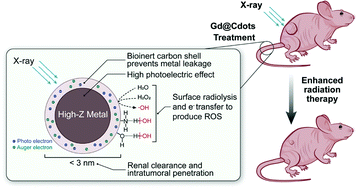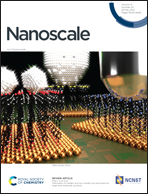Ultrasmall Gd@Cdots as a radiosensitizing agent for non-small cell lung cancer†
Abstract
High-Z nanoparticles (HZNPs) afford high cross-section for high energy radiation and have attracted wide attention as a novel type of radiosensitizer. However, conventional HZNPs are often associated with issues such as heavy metal toxicity, suboptimal pharmacokinetics, and low cellular uptake. Herein, we explore gadolinium-intercalated carbon dots (Gd@Cdots) as a dose-modifying agent for radiotherapy. Gd@Cdots are synthesized through a hydrothermal reaction with an ultrasmall size (∼3 nm) and a high Gd content. Gd@Cdots can significantly increase hydroxyl radical production under X-ray irradiation; this is attributed to not only the photoelectric effects of Gd, but also the surface catalytic effects of carbon. Because carbon is biologically and chemically inert, Gd@Cdots show low Gd leakage and minimal toxicity. In vitro studies confirm that Gd@Cdots can efficiently enhance radiation-induced cellular damage, causing elevated double strand breaks, lipid peroxidation, and mitochondrial depolarization. When tested in mice bearing non-small cell lung cancer H1299 tumors, intravenously injected Gd@Cdots plus radiation leads to improved tumor suppression and animal survival relative to radiation alone while causing no detectable toxicity. Our studies suggest a great potential of Gd@Cdots as a safe and efficient radiosensitizer.



 Please wait while we load your content...
Please wait while we load your content...